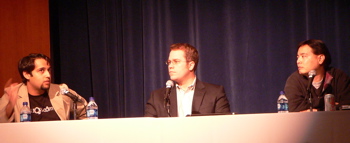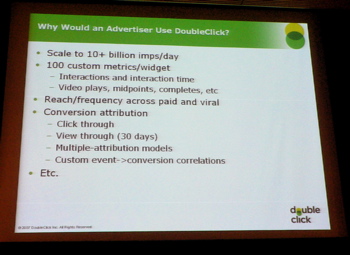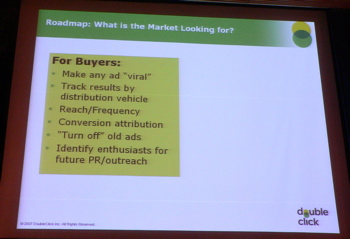[Okay, it’s actually Day 2 now, and I’m sitting in the main hall getting ready for today’s sessions to get rolling. But I still have posts to do about Day 1! So, please bear with me (bad wi-fi in my hotel, you know….in SF??), while I keep playing catch up…]
"Monetization" is what this panel is about, said Saar Gur, a partner with Charles River Ventures. He introduced Lance Tokuda, the CEO of RockYou, to kick things off — and Lance was happy to brag up his business to no end for us. "We offer 40 widgets…one of every four online users has one…and we’re number-one in engagement," he said. A very key point that Tokuda made is that networks with an API give your widgets "seven times the distribution." 
That’s Facebook now, of course, "but more are coming soon." He said that RockYou is "the largest CPI widget ad network." What’s CPI, you ask? Cost per install. "Widget distribution is hard," said the RockYou CEO. "Only 1% succeed." But, he wanted to make sure we all understood that "third-party ad networks enable better distribution" — specifically, he said their experience is 30 to 100 times better with ad support.
Doubleclick’s VP of rich media, Ari Paparo, says his firm is "enabling widget advertising." They’re helping advertisers take campaigns viral by putting elements like an "Ad to Google" or "Share" button in their ads. "We offer 100 different custom metrics per widget — the advertisers are demanding these."

Peanut Labs CEO, Murtaza Hussain, said his firm "helps widget companies monetize through market research." With a Facebook app they designed, they allow people to earn money by taking surveys. They have 120 research clients, and an industry-leading 29% response rate.
Moderator Gur jumped back in to mention some other ways that people are looking at monetizing: "affiliate links, the iLike model, and using virtual currency." Then he popped a good question to the panel: "How much are all widget companies now generating, in total, in the way of revenues?" Are you ready for the answer to this one? "Maybe $1 million per month," said RockYou’s Tokuda, causing a collective yet silent gasp to go up from the crowd. "Those who try to get installs by themselves fail," he said. In the next breath, he said it works much better, of course, to get a firm like his to advertise for you, to get those installs. The moderator pointed out that, when we talk monetization of widgets, the majority of revenues is very definitely now coming from advertising. What were some ideas for future monetization, he asked? Peanut Labs: "Premium models." Doubleclick: "It may sound boring, but commerce." RockYou: "Delivering games into social networks."
Next question: "Who are the first-mover types of advertisers in this space, and are they more brand focused or direct response?" 
Doubleclick’s Paparo jumped in: "Definitely brand advertisers," he said. "And we see the first-movers especially in the theatrical (movies) and auto categories." Peanut Labs’ Hussain: "Any advertiser looking to understand the Gen Y demographic." He said his firm asks 16 demographic and psychographic questions of its survey respondents.
The moderator then asked: "What kinds of packages are you selling, with what metrics?" RockYou: "Most just want to know the clickthrough to their site — Dell, for example. We’re also seeing a preference for Facebook buys." When asked what the going rate was for an install, Tokuda said anywhere from 50 cents to $1.00 is the CPI rate for RockYou. He said a blogger his company follows recently reported that RockYou is getting double what others are charging, which he obviously takes great pride in.
"Before a widget maker launches, what advice would you give him or her?" moderator Gur asked. Peanut Labs: "Do market research!" He also would advise looking at virtual currencies, "which are strong." Doublclick would recommend using just standard ad units. "Collecting demographic data is over-rated." RockYou said to get your page views maximized, and that the demographic of young girls is a great way to do that. "How do you scale?" the moderator followed up. "You’ll start with an ad network, then eventually go to a direct model," said Doubleclick. And what do you need to support ad sales? "You’d need an ad server of your own. But you’re probably not going to go direct for a while. I mean, if annual revenues in the whole widget industry is only $12 million right now, then it could only support 10 sales people!" The moderator switched gears: "As your widget develops, what’s a good time to start advertising?" RockYou: "I’d say maybe one million impressions per day." At that point, he said, it could make you $1000 a day." Speaking of sales people, Peanut Labs said it’s stopped accepting more publishers because it doesn’t have the sales people to support them.
In the panel followup and audience Q&A session, moderator Saar Gur said he thinks the real business models for widgets are still three to five years out. Doubleclick’s Paparo offered up some more insight into the current advertising picture. "It’s no secret that banner ads on Facebook aren’t selling well right now," he said. "The successes of banner ads on social networks in general are fairly spotty." But perhaps the most interesting comment he made was this last one: "Ads can’t be widgets — they’re different things. That’s how a lot of the brands I’m talking to are thinking."
 It’s hard to argue that the man doesn’t see the big picture. This recent article in the New York Times tells the story very well:
It’s hard to argue that the man doesn’t see the big picture. This recent article in the New York Times tells the story very well:  On hard times lately, the agency recently announced that its chairman, Pat Fallon, was
On hard times lately, the agency recently announced that its chairman, Pat Fallon, was 
Recent Comments